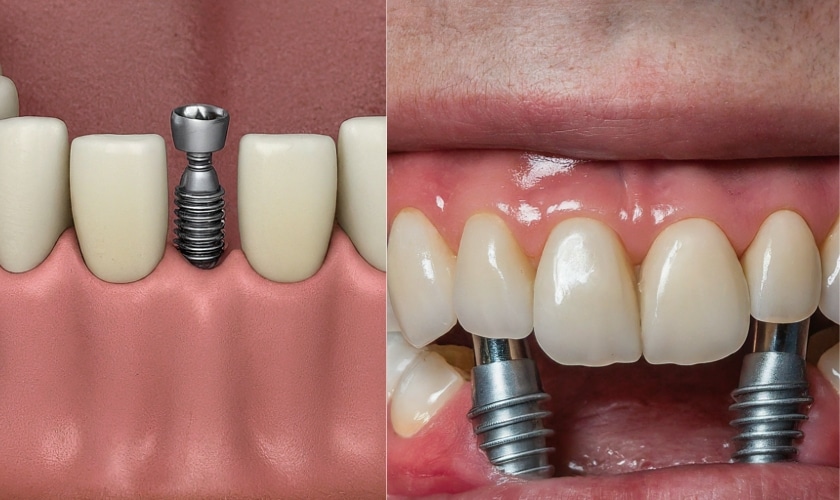10 Easy Facts About Dental Sense Described
Dental Sense Can Be Fun For Anyone
Table of ContentsHow Dental Sense can Save You Time, Stress, and Money.Not known Factual Statements About Dental Sense Little Known Facts About Dental Sense.Dental Sense - Truths
are clinical tools surgically implanted right into the jaw to restore a person's capability to eat or their appearance. They supply assistance for synthetic (phony) teeth, such as crowns, bridges, or dentures. When a tooth is shed due to injury or disease, an individual can experience issues such as rapid bone loss, faulty speech, or adjustments to eating patterns that cause pain.Oral implant systems include an oral implant body and dental implant abutment and might additionally consist of an abutment fixation screw. Dental implant vs bridge. The oral implant body is operatively placed in the jawbone instead of the tooth's origin. The oral implant joint is normally connected to the dental implant body by the abutment addiction screw and extends through gums into the mouth to support the connected synthetic teeth
(https://giphy.com/channel/dentalsense1)Structure of The Dental Implant System choosing dental implants, talk with your dental service provider about the possible advantages and dangers, and whether you are a candidate for the procedure. Things to think about: Your overall health is a vital consider identifying whether you are an excellent prospect for oral implants, just how long it will require to heal, and the length of time the implant might remain in place.
Smoking cigarettes may affect the recovery process and lower the long-lasting success of the dental implant. The healing procedure for the dental implant body may take several months or longer, throughout which time you typically have a momentary joint in area of the tooth. the oral implant treatment: Meticulously comply with the dental health directions provided to you by your oral supplier.
Fascination About Dental Sense
Implant failing can result in the requirement for an additional operation to take care of or change the dental implant system. Restores the capability to eat Restores aesthetic appearance Helps keep the jawbone from diminishing because of bone loss Preserves the health and wellness of the bordering bone and gums Helps maintain nearby (close-by) teeth stable Enhances high quality of life Damages to bordering natural teeth throughout dental implant placement Injury to the surrounding cells throughout surgical procedure, such as sinus opening Injury during surgical procedure (for instance, crack of surrounding jawbone) Poor function, such as feeling like the teeth do not attack together normally A sensation that the tooth hangs or twisting in location arising from an abutment screw loosening up Implant body failing (looseness of the dental implant body) because of systemic infection, which may be most likely in patients with unchecked diabetes mellitus due to regional infection in bone and gums sustaining the implant body as a result of delayed healing, which might be most likely in clients who smoke Difficulty cleaning the gums around the dental implant, resulting in bad oral health Without treatment periodontal condition Post-surgical tingling as a result of nerve impingement or damage Constantly notify health and wellness treatment suppliers and imaging professionals that you have dental implants before any kind of magnetic resonance imaging (MRI) or x-ray treatments.
FDA is not conscious of any kind of adverse occasions reported for MRI or x-ray procedures with dental implants. Dental implants systems are usually made from materials that follow worldwide agreement criteria of the International Company for Standardization (ISO) or ASTM International. These requirements have information of what makes a risk-free product.

A dental implant is a framework that replaces a missing tooth. With screw-like devices, the surgeon inserts an implant right into the jawbone, and it serves as a support for a synthetic tooth, called a crown. A device called an abutment connects the fabricated tooth to the dental implant. The crown is custom-made to fit the individual's mouth and match the shade of their teeth.
Dental Sense Fundamentals Explained
Some individuals are not qualified for dental implant surgery. It is for oral cosmetic surgeons to operate people with: severe illnessuncontrollable metabolic diseasebone or soft cells disease or infectionIf these issues are settled, a person can have the surgery. In, dental specialists avoid from operating on individuals with: If people with any of the above undertake oral implant surgery, there is a higher threat of the implant stopping working.

Oral implant surgery is a tailored process. Give you time to heal. Attach the article and last crown, bridge or denture.
Next, your specialist will thoroughly put the oral implant right into your jaw. Your doctor will reposition your gum tissues and close the cut with stitches. If your implant is near the front of your mouth, your dental practitioner will make a short-lived tooth for you to put on till you heal. That method, you won't have a space in your smile while you recoup.
Not known Facts About Dental Sense
Your supplier can tell you what to expect in your scenario. During the recovery phase, your jawbone ought to fuse to the oral implant. This process, called osseointegration, is essential for stability and long-term success. This process can take anywhere from three to nine months. Sometimes, it may take much longer.
When your implant heals, your dental practitioner can attach the joint (little connector message) and your last remediation (crown, bridge or denture). This generally takes regarding one hour to finish and might require a 2nd minor surgical treatment. You shouldn't feel any type of discomfort during your oral implant treatment since your provider will use drug to numb your periodontals.